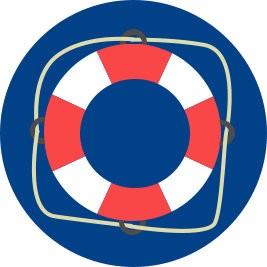Dry Drowning Debunked
You may have heard of stories about children experiencing a potential drowning incident, appearing to have not suffered any serious complications, only to stop breathing hours or maybe even a week after the original incident. This event has been labeled "dry drowning" or "secondary drowning" and has spread across social media like wildfire on more than one occasion.
The name itself is a myth. The term "dry drowning" insinuates that the event didn't occur due to inhalation of a liquid (usually water). According to the Merriam-Webster dictionary, "drowning" is by definition, "to suffocate by submersion, especially in water." Dry drowning is an oxymoron and should be seen as the contradictory and inaccurate term that it is. It's also important to know the difference between swallowing water and inhaling water. Swallowing water is parallel to drinking water, though you may need to be aware of the bacteria that was consumed depending on the water source. Inhalation is the point of concern when it comes to drowning. If water is inhaled, the larynx spasms which causes the vocal cords to contract, effectively blocking the airway and preventing oxygen from entering the lungs. According to WebMD, this makes up only 1%-2% of all drownings.
This isn't to say that drowning isn't a real and scary possibility for children. Small children may not be able to accurately explain what symptoms they're experiencing so it's important to know the signs of liquid inhalation. However, it's important to note that these symptoms will be extremely visible to the parent or guardian. If these symptoms are experienced, it's important to seek medical attention immediately as drowning can be interrupted through CPR.
CPR is a vital life skill for anyone and everyone. As a parent, it's important to be knowledgeable about CPR and how it should be performed on both adults and children. If you notice your child experiencing symptoms of water inhalation it's crucial to first call 9-1-1, and then begin CPR after you have followed the necessary procedures for identifying if the victim requires CPR. You never know when this skill can truly be the difference between life and death, and this is why we are dedicated to all of our Atlanta Swim Academy staff members being CPR and First Aid certified.
Another preventative measure for drowning is having your child enrolled in swim lessons. Here at Atlanta Swim Academy, we offer year-round swim lessons for kids of all ages. We believe preventative measures are the best way to avoid a tragedy. Through our lessons, your child will learn to be comfortable and safe in the water and will be taught various swimming skills. These lessons are not only a great way for your child to have fun and get some energy out but are also an excellent way to make sure they're confident in the water.
We want our swimmers and their parents to be aware and prepared if an incident does occur, but we also want our students and their parents to enjoy this sport. For more information regarding dry drowning, read 'Dry drowning' and other myths, by the Cleveland Journal of Medicine.
This isn't to say that drowning isn't a real and scary possibility for children. Small children may not be able to accurately explain what symptoms they're experiencing so it's important to know the signs of liquid inhalation. However, it's important to note that these symptoms will be extremely visible to the parent or guardian. If these symptoms are experienced, it's important to seek medical attention immediately as drowning can be interrupted through CPR.
CPR is a vital life skill for anyone and everyone. As a parent, it's important to be knowledgeable about CPR and how it should be performed on both adults and children. If you notice your child experiencing symptoms of water inhalation it's crucial to first call 9-1-1, and then begin CPR after you have followed the necessary procedures for identifying if the victim requires CPR. You never know when this skill can truly be the difference between life and death, and this is why we are dedicated to all of our Atlanta Swim Academy staff members being CPR and First Aid certified.
Another preventative measure for drowning is having your child enrolled in swim lessons. Here at Atlanta Swim Academy, we offer year-round swim lessons for kids of all ages. We believe preventative measures are the best way to avoid a tragedy. Through our lessons, your child will learn to be comfortable and safe in the water and will be taught various swimming skills. These lessons are not only a great way for your child to have fun and get some energy out but are also an excellent way to make sure they're confident in the water.
We want our swimmers and their parents to be aware and prepared if an incident does occur, but we also want our students and their parents to enjoy this sport. For more information regarding dry drowning, read 'Dry drowning' and other myths, by the Cleveland Journal of Medicine.
Learn more about our year-round swim lessons or fill out our contact us form to get your child started with swim lessons!




Comments